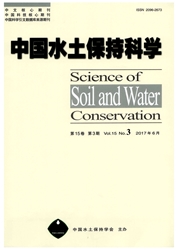

 中文摘要:
中文摘要:
为了研究淤地坝对流域径流过程的影响,阐明淤地坝的减蚀机制,以淤地坝系布设完整的黄土高原丘陵沟壑区第一副区典型流域为研究对象。首先,从表观上分析水土保持措施对径流系数、输沙模数和流域滞时的影响,发现韭园沟、王茂沟、想她沟较未治理的裴家峁、李家寨、团园沟径流系数分别减少了29.43%、34.63%、16.78%,输沙模数分别减少了28.09%、67.75%、27.75%;其次,通过构建单位过流量的概念,分析淤地坝淤积对沟道过流能力的影响,淤地坝淤积降低了沟道的过流能力,淤积沟道的单位过流量降为未淤积沟道的40%;最后,借助图论理论,定义沟道汇聚节点、沟道障碍性节点(淤地坝)以及沟道特征变换点3类沟道节点,并将沟道障碍性节点依据其放水建筑物类别划分为强连通性结点、弱连通性结点、无连通性结点3个子类。对每类节点赋予权重,计算出整个王茂沟流域的权重值(0.21),经过和实测的洪峰流量拟合,发现权重值和洪峰流量之间有较好相关性。研究结果对分析淤地坝等水土保持措施对流域水文过程的影响有一定意义。
 英文摘要:
英文摘要:
In order to explore the effect of check dams on runoff process and elucidate the mechanism underlying erosion reduction, we chose a representative basin in the first sub-region of the hilly and gully loess region with well-established check dam system as the research subject. Firstly, we analyzed the influence of check dams on runoff coefficient, sediment transport modulus and basin lag time. The result shows that the runoff coefficient of Jiuyuangou, Wangmaogou and Xiangtagou was reduced by 29.43% , 34.63% and 16.78% and the sediment runoff modulus was decreased by 28.09%, 67.75% and 27.75% , respectively, compared with Peijiamao, Lijiazhai and Tuanyuangou which were not governed. The basin lag time of Wangmaogou was 117 min, almost three times longer than that of Lijiazhai. Secondly, we analyzed the effects of the check dam siltation on flow discharging capacity through establishing the unit discharge concept. We defined the flow of cross section of any channel under 1 m water level as the specific rate of flow. A Chezy formula was used to calculate the flow through the channel unit. The results illustrated that the flow rate of natural channel unit was 41.82 m3/s, while the flow rate of check dam was 17.13 m3/s. With the dam siltation, deposition reduced the flow capacity of the channel, and the unit flow rate of channel was reduced to 40% of the original. Finally, we defined three kinds of the river nodes which are reach junction (river junction) , reach barriers node (check dam) and reach feature transform node (the transition point of natural channel to siltation channel), and divided the reach barriers node into three sub-categories which are strong connectivity node (spillway), weak connectivity node (shaft and horizontal pipes) and disconnected node (check dam without water facilities) based on the category of water release works. According to the unit flow, we assigned weight to each kind of node, constructed the river tree graph of Wangmaogou watershed by graph theory, and calcu
 同期刊论文项目
同期刊论文项目
 同项目期刊论文
同项目期刊论文
 期刊信息
期刊信息
